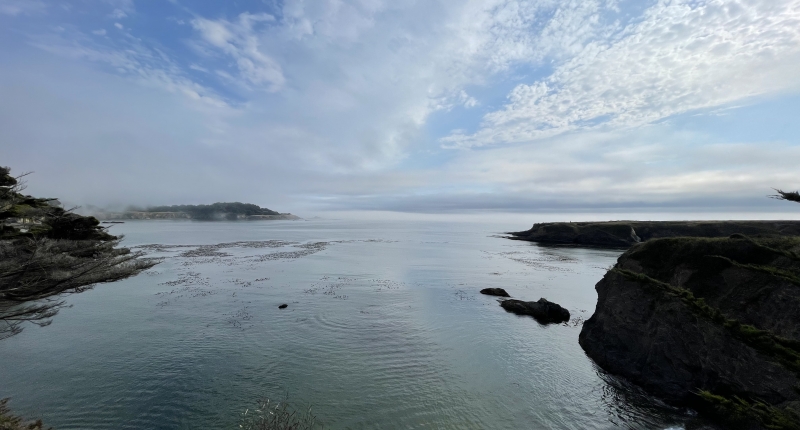NCEAS Leads Ten-Year Review of California’s MPA Network

California has one of the most extensive networks of Marine Protected Areas (MPAs) in the world. Several decades in the making, managers of the network are now tasked with answering a pivotal question – is it working?
For fish, the answer seems to be “yes, in some places.” Synthesizing ten years of data across the 124-site network was no small task. The National Center for Ecological Analysis & Synthesis (NCEAS) was one of the groups chosen to lead this effort due to the need to generate findings across multiple disciplines for a range of users and regulators. NCEAS Project manager Heather Lahr reflected on the role of the working group model for this unique task: “We bring in interdisciplinary teams to holistically approach complex questions – This team in particular was interested in understanding all angles of MPA impacts and has had to continuously evolve their research questions.”
One product from the assembled Working Group was the recently published MPA Monitoring Synthesis Report. It outlines the goals of the network and how it is – or isn’t – meeting its founding objectives. At a high level, the network is producing bigger and more fish at some sites. These effects are stronger in areas with higher fishing pressure, specifically in the southern region of the state.
Since the publication of the report, the working group continued to bring together insights from different geographies and ecosystem types to develop a more holistic assessment of our MPAs. Cori Lopazanski, a UC Santa Barbara graduate student on the working group and one of the lead analysts for the project, explains, “our primary charge was to synthesize data across habitat types, most of which had only been evaluated individually.”
The working group is now focused on publishing several standalone analyses related to different aspects of the MPA network. NCEAS has granted the working group “free range to explore interesting questions and share the results,” says Lopazanski. This is allowing them to ask questions like “did the MPA network protect against the impacts of the 2014 to 2016 Marine Heat Wave?”
This is one of the questions that will be addressed in a forthcoming analysis led by working group member Joshua Smith. In a video call, Smith clarified that the study assessed whether the network of MPAs conferred ecological resilience to the marine heatwave known as the “blob”, where Pacific Ocean temperatures were elevated for the longest period ever recorded. "We found that along the central coast of California, the marine heatwave had dramatic impacts on community structure across multiple ecosystems, regardless of whether the communities were inside of MPAs.” Smith stressed, “climate change can have all sorts of different manifestations, but the highly visible impacts of marine heatwaves ─ like kelp forest loss ─ is something that really resonates with a lot of people.”
In addition to an examination of climate resilience across the network, the working group is moving to publish an assessment of how people are using and engaging with different MPAs. For Jacob Eurich, an Environmental Defense Fund scientist, and others in the working group, there are equally important questions researchers and managers are being called to address – “in addition to resilience of what, to what, it’s resilience for whom?” According to the large number of Indigenous leaders and Tribal representatives in the room for the DMR review meetings held in mid-March, the answer is “not for us.”
The Tribal Summary of the DMR outlines a legacy of exclusion of Indigenous perspectives and priorities from California’s MPA network governance. Tribal science has also been historically underfunded, leading to gaps in data around culturally important ecosystems and practices in regions like the North Coast. This is a top priority for organizations like the Tribal Marine Collaborative (TMC). According to its president, Ruthie Maloney, “traditional land and water stewardship practices are interwoven with Indigenous identity.” On several calls and email exchanges in May, Maloney stressed “TMC intends to provide a bottom-up, grassroots approach to cultural management endeavors inclusive of all Indigenous Peoples … without speaking on behalf of any Tribe.”
TMC and the NCEAS Working Group are both seeking to understand where and how Indigenous People have been involved in MPA research and management. Eurich acknowledged that “there is limited data at an MPA level for cultural or Tribal engagement and moving forward, represents a critical gap to address.” A tool MPA managers do have is the TMC-led Best Practices for Tribal Engagement. TMC wants to understand “how much this is being utilized within the MPA network” and if there is “any commitment or plan to follow these structures that have been provided by Indigenous researchers.”
The document emphasizes that no Indigenous people were included in the MPA network’s original Science Advisory Team. The NCEAS working group members are now seeking to expand on this by quantifying Tribal engagement at an MPA-level. Eurich referenced this as a component of a broader “performance synthesis” of the network, which will use the “Nature Futures Framework.” The framework is a tool developed by an international group of researchers and is designed to emphasize positive human-nature relationships.
Understanding the current extent of Native involvement in coastal governance can strengthen research partnerships and build Tribal capacity. Addressing these gaps reinforces the Working Group’s original mandate to approach MPA impacts from “all angles.” It also demonstrates a responsiveness to the comments raised by Indigenous communities and can help guide the next steps towards more collaborative management of California’s MPAs.
Conner Smith is a Graduate Student at the UCSB Bren School of Environmental Science and Management. He is researching this topic as a Fellow funded under the Leadership for Climate Resilient Fisheries Fellowship from the Sustainable Ocean Alliance and Environmental Defense Fund.
